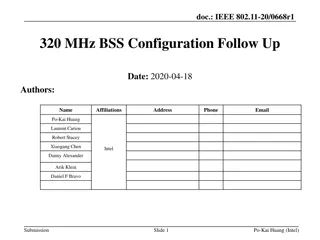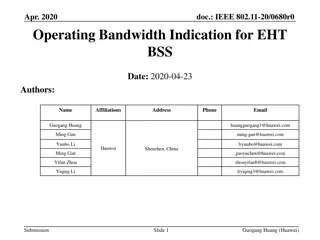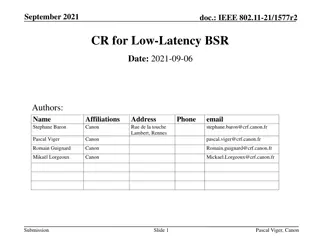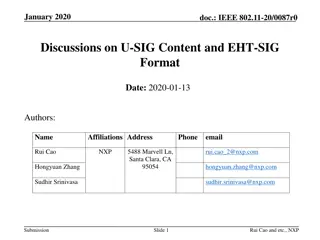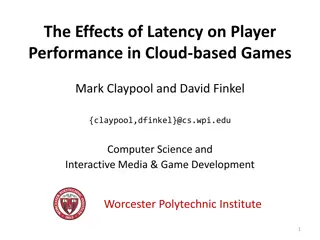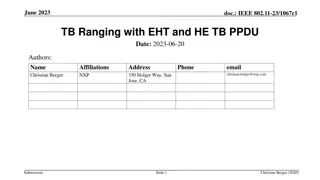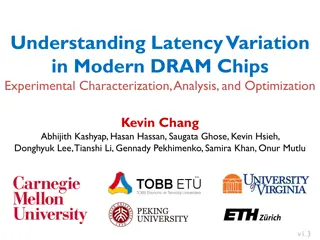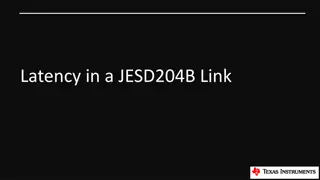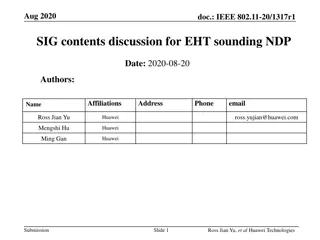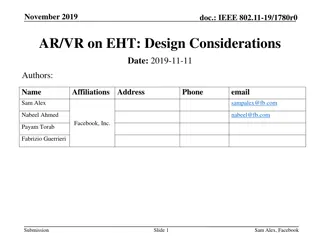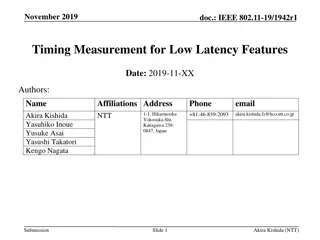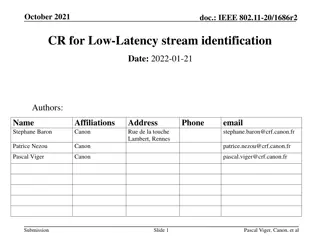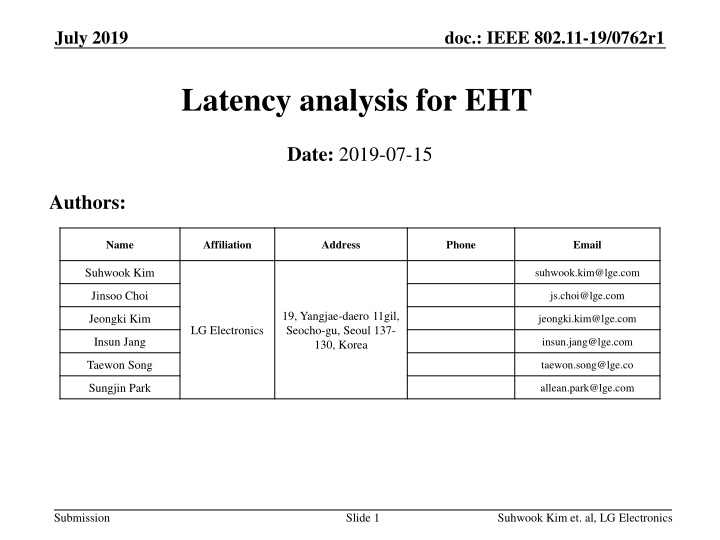
Latency Analysis for Enhanced High Throughput WiFi (EHT) - July 2019 Presentation
This presentation delves into the critical analysis of latency for Enhanced High Throughput WiFi (EHT), aiming to reduce latency and jitter for improved performance. It discusses simulation results for both EDCA and OFDMA systems within the IEEE 802.11 framework, offering insights to support low latency traffic and enhance user experience in various real-time applications such as virtual reality, gaming, and cloud computing over WLAN.
Download Presentation

Please find below an Image/Link to download the presentation.
The content on the website is provided AS IS for your information and personal use only. It may not be sold, licensed, or shared on other websites without obtaining consent from the author. If you encounter any issues during the download, it is possible that the publisher has removed the file from their server.
You are allowed to download the files provided on this website for personal or commercial use, subject to the condition that they are used lawfully. All files are the property of their respective owners.
The content on the website is provided AS IS for your information and personal use only. It may not be sold, licensed, or shared on other websites without obtaining consent from the author.
E N D
Presentation Transcript
July 2019 doc.: IEEE 802.11-19/0762r1 Latency analysis for EHT Date: 2019-07-15 Authors: Name Affiliation Address Phone Email Suhwook Kim suhwook.kim@lge.com Jinsoo Choi js.choi@lge.com 19, Yangjae-daero 11gil, Seocho-gu, Seoul 137- 130, Korea Jeongki Kim jeongki.kim@lge.com LG Electronics Insun Jang insun.jang@lge.com Taewon Song taewon.song@lge.co Sungjin Park allean.park@lge.com Submission Slide 1 Suhwook Kim et. al, LG Electronics
July 2019 doc.: IEEE 802.11-19/0762r1 Abstract This presentation addresses the latency analysis for EHT to reduce latency and jitter. This analysis may allow EHT to review technologies to support low latency traffic. This presentation provides the simulation results for EDCA system and OFDMA system which has been adopted in 802.11 Submission Slide 2 Suhwook Kim et. al, LG Electronics
July 2019 doc.: IEEE 802.11-19/0762r1 Low latency support discussion We have discussed supporting low latency application in EHT Low latency is mentioned in several sub-clauses in the PAR document 5.2.b. Scope of the project: This amendment defines at least one mode of operation capable of improved worst case latency and jitter. 5.5 Need for the Project: New high-throughput, low latency applications will proliferate such as virtual reality or augmented reality, gaming, remote office and cloud computing . With the high throughput and stringent real-time delay requirements of these applications, users expect enhanced throughput, enhanced reliability, reduced latency and jitter, and improved power efficiency in supporting their applications over WLAN. Submission Slide 3 Suhwook Kim et. al, LG Electronics
July 2019 doc.: IEEE 802.11-19/0762r1 Submissions in previous meetings [1] introduces Real Time Application and Time-Sensitive Networking RTA TIG provides final report (18/2009r6) which contains description of real-time application usage model, problem statement, technical requirements and potential solutions It addresses opportunity for improving reliability for RTA and time- sensitive applications in EHT [2] proposes multiple primary channels for EHT to mitigate channel access delay It also shows simulation results [3] suggests streaming game as a part of EHT use case Submission Slide 4 Suhwook Kim et. al, LG Electronics
July 2019 doc.: IEEE 802.11-19/0762r1 Latency analysis method The latency will be analyzed by dividing into several portions It takes a lot of process for a frame to be sent For example, queuing, contention, IFS, retransmission, etc In OFDMA system, scheduling and feedback take additional time To facilitate the better analysis, we will start with the analysis in limited environment DL or UL only traffic Single BSS Constant Bit Rate (CBR) traffic Fixed MCS Submission Slide 5 Suhwook Kim et. al, LG Electronics
July 2019 doc.: IEEE 802.11-19/0762r1 Latency portions EDCA TW: Contention waiting time Time to transmit previously arrived packets TC: Contention time TR: Additional time for retransmission Time spent for failed transmission TTX: Transmission time for successful data frame and ACK Submission Slide 6 Suhwook Kim et. al, LG Electronics
July 2019 doc.: IEEE 802.11-19/0762r1 Latency analysis on EDCA In DL case, MCS that maximizes Tput and MCS that minimizes latency can be different The latency increases dramatically when traffic is saturated The variation in TW is greater than the others In UL case, RTS/CTS shows enhanced performance not only in Tput but also in latency when the number of STAs is above a certain level Unlike in DL case, the portion of TC,TR by collision increases significantly if the number of STAs increases We can enhance latency performance of certain traffic dramatically by allocating AC_VI,VO instead of AC_BE Simulation results for EDCA are attached in appendix Submission Slide 7 Suhwook Kim et. al, LG Electronics
July 2019 doc.: IEEE 802.11-19/0762r1 Latency portions DL OFDMA TS: Scheduling time Time to be scheduled for DL TC: Contention time TTX: Transmission time for successful data frame and ACK TR: Additional time for retransmission Submission Slide 8 Suhwook Kim et. al, LG Electronics
July 2019 doc.: IEEE 802.11-19/0762r1 Latency portions UL OFDMA TS: Scheduling time Time to be scheduled for UL (Including Trigger frame transmission) Latency for feedback procedure is not assumed TTX: Transmission time for successful data frame and ACK TR: Additional time for retransmission Submission Slide 9 Suhwook Kim et. al, LG Electronics
July 2019 doc.: IEEE 802.11-19/0762r1 Simulation setting AP-STA distance: 15 meter All STAs are co-located Channel model: TGnD Fixed MCS (MCS 9), 80 MHz BW Traffic model: CBR (20 Mbps), DL or UL only TX power: 20 dBm(AP), 17 dBm(STA) Scheduler: 1 RU per 1 STA 1 RU * 996 tones 2 RUs * 484 tones 4 RUs * 242 tones 8 RUs * 106 tones 16 RUs * 52 tones AP STAs Submission Slide 10 Suhwook Kim et. al, LG Electronics
July 2019 doc.: IEEE 802.11-19/0762r1 Simulation cases for DL OFDMA Case 1: Number of STAs 1, 4, 8, 16 STAs Case 2: RU sizes 8 STAs: 8 * 106 / 4 * 242 / 2 * 484 tones 16 STAs: 16 * 52 / 8 * 106 / 4 * 242 tones Case 3: Scheduler 8 STAs: 8 * 106 / 4 * 242 / 2 * 484 tones Latency minimized scheduler / Persistent scheduler Latency minimized scheduler Choose the STAs that have the most delayed frames Persistent scheduler Assign one RU for the pre-selected STA in every TXOP Remaining RUs are selected by latency minimized scheduler Submission Slide 11 Suhwook Kim et. al, LG Electronics
July 2019 doc.: IEEE 802.11-19/0762r1 DL Latency analysis: Case 1 (Number of STAs) Total Latency [usec] Tput [Mbps] PER [%] 1 STA 20.0 6.8 219 4 STAs 20.0 9.7 622 8 STAs 20.0 13.1 1,842 16 STAs 19.9 18.3 19,951 Submission Slide 12 Suhwook Kim et. al, LG Electronics
July 2019 doc.: IEEE 802.11-19/0762r1 DL Latency analysis: Case 2 (RU sizes) Submission Slide 13 Suhwook Kim et. al, LG Electronics
July 2019 doc.: IEEE 802.11-19/0762r1 DL Latency analysis: Case 3 (Scheduler) 8 * 106 tones 4 * 242 tones 2 * 484 tones Submission Slide 14 Suhwook Kim et. al, LG Electronics
July 2019 doc.: IEEE 802.11-19/0762r1 Observation on DL results If the network is saturated, changes in RU sizes don t make meaningful difference on latency performance If the network isn t saturated, the larger RU size, the better latency performance in DL Even though the TS has increased, the TTX has decreased more in larger RU size Like EDCA case, the variation in TS is greater than the others Persistent scheduler can dramatically improve latency performance of a specific STA Performance gain is higher in larger RU size Submission Slide 15 Suhwook Kim et. al, LG Electronics
July 2019 doc.: IEEE 802.11-19/0762r1 Simulation cases for UL OFDMA Case 1: Number of STAs 2, 4, 8, 16 STAs UL TXOP: 4.6 msec or 2 msec Case 2: RU sizes 16 STAs: 16 * 52 / 8 * 106 / 4 * 242 tones Case 3: Scheduler 16 STAs (52 tones, 106 tones, 242 tones), 10 Mbps per STA Latency minimized scheduler / Persistent scheduler Latency minimized scheduler Choose the STAs that have the most delayed frames Persistent scheduler Assign one RU for the pre-selected STA in every TXOP Remaining RUs are selected by latency minimized scheduler Submission Slide 16 Suhwook Kim et. al, LG Electronics
July 2019 doc.: IEEE 802.11-19/0762r1 UL Latency analysis: Case 1 (Number of STAs) 297 Submission Slide 17 Suhwook Kim et. al, LG Electronics
July 2019 doc.: IEEE 802.11-19/0762r1 UL Latency analysis: Case 2 (RU sizes) 297 Submission Slide 18 Suhwook Kim et. al, LG Electronics
July 2019 doc.: IEEE 802.11-19/0762r1 UL Latency analysis: Case 3 (Scheduler) 8 * 106 tones 4 * 242 tones 16 * 52 tones Submission Slide 19 Suhwook Kim et. al, LG Electronics
July 2019 doc.: IEEE 802.11-19/0762r1 Observation on UL results Unlike in DL case, the number of STAs doesn t affect the latency performance However, if the number of STAs increases until the network is saturated, the latency increases rapidly The latency performance improves with smaller UL TXOP, but the network can be saturated in less offered traffic load because of the overhead of trigger frame and padding Unlike in UL EDCA case, only TS is dominant factor because there isn t contention and collision There isn t TC in UL OFDMA and TR is very low To reduce latency in UL, it may be recommended that AP more frequently assign a smaller RU to STAs Submission Slide 20 Suhwook Kim et. al, LG Electronics
July 2019 doc.: IEEE 802.11-19/0762r1 Expectation on OBSS Because we assumed single BSS, there wasn t frame error caused by OBSS interference So, TR and TC didn't have a big impact on latency except UL EDCA case We can assume that the portion of TR and TC increases in OBSS The worst-case scenario of a rapid increase in latency usually occurs in OBSS or dense environment, the portion of TR and TC may be important factors for handling worst-case TS should also be considered as important factor in OFDMA Submission Slide 21 Suhwook Kim et. al, LG Electronics
July 2019 doc.: IEEE 802.11-19/0762r1 Further step Applying TST (time sensitive traffic) model We will apply TST which is defined in 11ax Evaluation Methodology document and RTA TIG report We will evaluate whether 11ax can satisfy TST requirements OBSS performance We will extend current simulation to OBSS environment Worst-case will be considered We will evaluate latency performance of EHT features Multi-band, 16 streams, 320 MHz, etc. Submission Slide 22 Suhwook Kim et. al, LG Electronics
July 2019 doc.: IEEE 802.11-19/0762r1 Summary We conducted in-depth latency analysis on EDCA and OFDMA system The latency is divided into several portions and analyzed with simulation We could identify some variables that affect latency We also were able to check some things to reduce latency by simulation results Submission Slide 23 Suhwook Kim et. al, LG Electronics
July 2019 doc.: IEEE 802.11-19/0762r1 References [1] 11-19-0373-00-0eht-time-sensitive-applications- support-in-eht.pptx [2] 11-19-0402-01-0eht-reducing-channel-access- delay.pptx [3] 11-19-0430-00-0eht-low-latency-streaming-capability- for-game-applications.pptx Submission Slide 24 Suhwook Kim et. al, LG Electronics
July 2019 doc.: IEEE 802.11-19/0762r1 Appendix I EDCA results Submission Slide 25 Suhwook Kim et. al, LG Electronics
May 2019 doc.: IEEE 802.11-19/0762r1 Simulation setting AP-STA distance: 45 meter All STAs are co-located Channel model: TGnD Fixed MCS Traffic model: CBR, DL or UL only, 1500 bytes MPDU TX power: 20 dBm(AP), 17 dBm(STA) 40, 80, 160 MHz BW in 5 GHz band AP STAs Submission Slide 26 Suhwook Kim et. al, LG Electronics
May 2019 doc.: IEEE 802.11-19/0762r1 Simulation cases for DL EDCA Case 1: MCS MCS 1 ~ 5 50 Mbps traffic load, 80 MHz BW Case 2: BW BW 40 MHz, 80 MHz, 160 MHz 50 Mbps traffic load, MCS 4 Case 3: Traffic load Traffic load 50 Mbps ~ 200 Mbps MCS 4, 80 MHz BW Submission Slide 27 Suhwook Kim et. al, LG Electronics
July 2019 doc.: IEEE 802.11-19/0762r1 DL Latency analysis: Case 1 (MCS) Total Latency [usec] Tput [Mbps] PER [%] MCS 5 47.3 46.6 15,689 15.7 MCS 4 50.0 6.9 694 MCS 3 50.0 0 614 MCS 2 50.0 0 854 MCS 1 50.0 0 2,464 Submission Slide 28 Suhwook Kim et. al, LG Electronics
July 2019 doc.: IEEE 802.11-19/0762r1 DL Latency analysis: Case 2 (BW) Total Latency [usec] Tput [Mbps] PER [%] 40 MHz 80 MHz 160 MHz 50.0 2.2 3,392 50.0 6.9 694 50.0 6.8 463 Submission Slide 29 Suhwook Kim et. al, LG Electronics
July 2019 doc.: IEEE 802.11-19/0762r1 DL Latency analysis: Case 3 (Traffic load) Total Latency [usec] Tput [Mbps] PER [%] 73.4 50 50.0 6.9 694 Mbps 100 Mbps 150 Mbps 200 Mbps 100.0 5.3 4,342 147.7 4.1 9,760 159.5 4.0 73,391 Submission Slide 30 Suhwook Kim et. al, LG Electronics
May 2019 doc.: IEEE 802.11-19/0762r1 Simulation cases Case 1: Number of STAs, 1 ~ 10 STAs Traffic load = 10 Mbps per STA, RTS/CTS on/off Case 2: Number of STAs, 10 ~ 40 STAs Traffic load = 1 Mbps per STA, RTS/CTS on/off Case 3: Access category, 6 STAs 5 low rate STAs + 1 high rate STA High rate STAs: 100 Mbps traffic load, AC_BE/VI/VO Low rate STAs: 1 Mbps traffic load per STA, AC_BE only RTS/CTS off Submission Slide 31 Suhwook Kim et. al, LG Electronics
July 2019 doc.: IEEE 802.11-19/0762r1 UL Latency analysis: Case 1 (Number of STAs) 635 90.0 Submission Slide 32 Suhwook Kim et. al, LG Electronics
July 2019 doc.: IEEE 802.11-19/0762r1 UL Latency analysis: Case 2 (Number of STAs) Submission Slide 33 Suhwook Kim et. al, LG Electronics
July 2019 doc.: IEEE 802.11-19/0762r1 UL Latency analysis: Case 3 (Access Category) Submission Slide 34 Suhwook Kim et. al, LG Electronics
July 2019 doc.: IEEE 802.11-19/0762r1 Appendix II OFDMA results Submission Slide 35 Suhwook Kim et. al, LG Electronics
July 2019 doc.: IEEE 802.11-19/0762r1 DL Latency analysis: Case 1 (Number of STAs) Detail results Each latency portion [usec] Tput [Mbps] PER [%] Total Latency [usec] TS TC TTX TR 2 66 141 10 1 STA 20.0 6.8 219 192 66 307 57 4 STAs 20.0 9.7 622 595 66 1052 129 8 STAs 20.0 13.1 1,842 15831 66 3361 693 16 STAs 19.8 18.3 19,951 Submission Slide 36 Suhwook Kim et. al, LG Electronics
July 2019 doc.: IEEE 802.11-19/0762r1 DL Latency analysis: Case 2 (RU sizes) Detail results Each latency portion [usec] Tput [Mbps] PER [%] Total Latency [usec] TS TC TTX TR 106 tones 20.0 13.1 1,842 595 66 1052 129 242 tones 20.0 11.6 1,365 695 66 481 123 8 STAs 484 tones 20.0 8.1 1,149 774 66 264 45 15,831 66 3,361 693 52 tones 20.0 18.3 19,951 21,631 66 4,917 581 16 STAs 106 tones 20.0 14.8 27,195 18,958 66 4,973 384 242 tones 19.8 9.1 24,381 Submission Slide 37 Suhwook Kim et. al, LG Electronics
July 2019 doc.: IEEE 802.11-19/0762r1 DL Latency analysis: Case 3 (Scheduler) Detail results Each latency portion [usec] Tput [Mbps] PER [%] Total Latency [usec] TS TC TTX TR Using 106 tones LM-SCH over 242 tones 20.0 P-SCH over 242 tones LM-SCH over 496 tones 20.0 P-SCH over 496 tones 20.0 13.1 11.6 5.5 1,842 1,365 680 595 695 306 66 66 66 1,052 481 277 129 123 31 Selected 20.0 The others 20.0 10.8 1,505 915 66 341 183 8.1 1.5 1,149 425 774 175 66 66 264 160 45 24 Selected 20.0 The others 20.0 6.9 1,637 1,227 66 287 57 Submission Slide 38 Suhwook Kim et. al, LG Electronics
July 2019 doc.: IEEE 802.11-19/0762r1 UL Latency analysis: Case 1 (Number of STAs) Detail results Each latency portion [usec] Total Latency [usec] Tput [Mbps] PER [%] TS TTX TR 2 STAs 4 STAs 8 STAs 16 STAs 2 STAs 4 STAs 8 STAs 16 STAs 20.0 20.0 20.0 20.0 20.0 20.0 20.0 17.2 3.4 2.6 1.3 0.8 4.2 2.8 1.7 0.8 7,127 7,256 7,120 7,534 3,128 3,137 3,155 296,560 2,347 2,347 2,387 2,934 1,045 1,050 1,106 294,730 4,501 4,485 4,453 4,405 1,901 1,885 1,853 1,805 279 423 280 196 182 202 196 25 4.6 msec 2 msec Submission Slide 39 Suhwook Kim et. al, LG Electronics
July 2019 doc.: IEEE 802.11-19/0762r1 UL Latency analysis: Case 2 (RU sizes) Detail results Each latency portion [usec] Tput [Mbps] PER [%] Total Latency [usec] TS TTX TR 52 tones 20.0 0.8 7,534 2,934 4,405 196 106 tones 4.6 msec 19.9 1.3 36,220 36,220 4,453 563 242 tones 19.9 2.5 55,117 55,117 4,485 2371 52 tones 17.2 0.8 296,560 294,730 1,805 25 106 tones 2 msec 19.6 1.4 90,095 88,127 1,853 114 242 tones 19.6 0.7 56,025 53,429 1,885 711 Submission Slide 40 Suhwook Kim et. al, LG Electronics
July 2019 doc.: IEEE 802.11-19/0762r1 UL Latency analysis: Case 3 (Scheduler) Detail results Each latency portion [usec] Tput [Mbps] PER [%] Total Latency [usec] TS TTX TR Using 52 tones 10.0 0.9 3,169 1,102 1,805 263 L-SCH over 106 tones P-SCH over 106 tones L-SCH over 242 tones P-SCH over 242 tones 10.0 1.5 5,016 2,745 1,853 418 Selected 10.0 1.3 2,985 1,046 1,853 85 The others 10.0 1.3 5,993 3,310 1,853 830 10.0 2.9 8,947 6,572 1,885 490 Selected 10.0 2.6 3,034 1,046 1,885 103 The others 10.0 2.7 13,771 9,907 1,885 1,979 Submission Slide 41 Suhwook Kim et. al, LG Electronics
July 2019 doc.: IEEE 802.11-19/0762r1 UL Latency analysis: Case 3a (Scheduler) 8 * 106 tones 4 * 242 tones 214 262 16 * 52 tones Submission Slide 42 Suhwook Kim et. al, LG Electronics
July 2019 doc.: IEEE 802.11-19/0762r1 UL Latency analysis: Case 3a (Scheduler) Detail results Each latency portion [usec] Tput [Mbps] PER [%] Total Latency [usec] TS TTX TR Using 52 tones 20.0 0.8 7,534 2,934 4,405 196 L-SCH over 106 tones P-SCH over 106 tones L-SCH over 242 tones P-SCH over 242 tones 19.9 1.3 41,236 36,220 4,453 563 Selected 20.0 0.8 6,857 2,344 4,453 60 The others 18.7 1.4 213,854 208,540 4,453 862 19.9 2.5 61,973 55,117 4,485 2371 Selected 20.0 3.2 7,066 2,350 4,485 231 The others 16.9 2.7 261,582 251,508 4,485 5589 Submission Slide 43 Suhwook Kim et. al, LG Electronics

